

Most undeservingly overhyped movie of all time??
... View MoreLet's be realistic.
... View MoreDon't listen to the Hype. It's awful
... View MoreThere are moments that feel comical, some horrific, and some downright inspiring but the tonal shifts hardly matter as the end results come to a film that's perfect for this time.
... View More"Der Golem" is surely one of the best German expressionist silent movies. It may be second only to "The Cabinet of Doctor Caligari"; I enjoyed it as much as Murnau's "Faust", and, truth be told, more than "Nosferatu".You probably already know the story: it's a well-known Jewish folk tale about a rabbi who constructs a stone creature (a golem) to protect his fellows from an anti-Semitic government in medieval Prague. The creature impresses the gentiles, but then it turns on its master.These movies aren't really about plot, nor characters. They're about mood, setting, and mise-en-scene. The golem itself is an indelible image; surprisingly it was played by the writer-director himself, who must have been a massive person. You can see the influence on James Whale's classic "Frankenstein". The settings are also sumptuous and fitting.My mind did wander, but not as much as when I watched Swedish silent "Korkarlen", also a horror film based on local myth. I appreciated that the story was easy to follow and interesting.
... View MoreYes this movie is precursor to the amazing 1931 Frankenstein. Everything you love about Frankenstein; first came from this movie. The way that Paul Wegener as the Golem move is similar to Boris Karloff's monster. The way, the clay monster is unsure what to do with the child is the same as Frankenstein's monster when meeting the girl at the lake. There are countless influences from the Golem that help how James Whale's Frankenstein's monster come alive on film. Even the old Golem Jewish legend would be used by Mary Shelley in her novel, Frankenstein. Paul Wegener was great in the role. His great facial expressions, Paul use is just awesome. The costume may looks funny because it looks like something that the star burst berries and cream little lad would wear, but Paul Wegener makes the Dutch-boy look scary with his astonishing make up. In my opinion, the Golem with its' forehead is written the Jewish word EMETH, which means "truth" looks scarier than this. The film was the last of three films about the Golem that Wegener made. It's the only one of three movies not to be lost due to time. The other two movies are The Golem (1915) and the short comedy The Golem and the Dancing Girl (1917), in which Wegener dons the Golem make-up in order to frighten a young lady he is infatuated with. This movie is a prequel to The Golem and is the best known of the series. This silent horror film by Paul Wegener serves as a great example of German Expressionism. German cinema was amazing in those silent era times with such hits like Nosferatu, Caligari, and the Golem is no exception! The Golem works well as a silence film character. The story goes like this, in 16th-century Prague, Jewish Rabbi Loew (Albert Steinruck) creates a giant creature from clay, called the Golem, and using sorcery, brings the creature to life in order to protect the Jews of Prague from persecution from the Holy Roman Emperor. However, the rabbi's assistant, Famulus (Ernst Deutsch) takes control of the golem and sends it forth to do his nefarious bidding, which includes abducting the beautiful Miriam (Lyda Salmonova), the Rabbi's beloved daughter. So the creature turns against its creator, and become loose in the city creating havoc. The script was adapted from the 1915 novel The Golem by Gustav Meyrink. That novel is based on Jewish folklore based on real-life person of Judah Loew ben Bezalel, the late-16th-century rabbi of Prague who is believed to have made a real-life golem at the time. I love the flickering images, the "Brandenburg Concerto" soundtrack, and the film's angular sets I like the newer DVD version, that had the newly composed soundtrack by Aljoscha Zimmermann incorporates Jewish melodies with folk dance material and is very actual. Here are the faults of the film. First off, the name is 'Golem' which means in Modern Hebrew as dumb or helpless. It's doesn't have that ringing of powerful creature. I miss the old bible meaning of 'my unshaped form', which makes more sense than the Modern Hebrew or Yiddish meaning. The film ending is a bit disappointing. Who knew a little girl can do that to a powerful monster? Even the restored print of the film, there are some cracks and imperfections still there. As a result, brightness varies moment to moment and the edges of the screen are generally quite muddy. The movie is a bit anti-Semitic, while it's somewhat portray the Jewish right, it's kinda doesn't. While they don't portray these characters are big-nosed money-grubbing Shylocks, but they do portray them as Wizards and witches that practicing the black arts, hints why the Emperor wanted the eviction of the ghetto Jews. Just think about this: this movie is made in 1920 Germany after it's defeat in 1918 in WWII. It's foreshadow a lot of what will happen in less than 15 years later. It is said that the house having that Golem was boarded up. Also that when Hitler invaded Prague, he ordered that that house be left alone. And, that it is still boarded up today. Something scared the people back then. Overall: for any silent era horror fan, it's a must watch. If not a silent era fan, it's not too hard to watch. It's very interesting. If the story doesn't get you, the music will. Give it a try as well.
... View MoreI watched it because the design and the story seemed to be nice, i wasn't disappointed about that. You can be sure when you watch this film, to see a beautiful golem and decorations. The others characters are also great, mostly Lyda Salmonova with her role of the Rabbi's daughter. I was also impressed by the soundtrack which fit nice with the pictures. The ending was pretty sad but it's how the movie finish and there were no alternative ending at this time. The directors aren't famous and "The Golem" is their only famous film, it's a bit sad because it's a nice movie. The theme of the Golem already have been done in cinema twice before this movie, an lost film released in 1915 and a comedy in 197 named "The Golem and the dancer".
... View MoreI have watched this 2 times; I got the Eureka DVD a few months ago. I decided to reinstate my thoughts about it today, as I did know it was a pretty good movie at first viewing, but I wanted to study what made it so goodThe story is relayed in 5 chapters; all of those can consist of intermissions.The first chapter is where Rabbi Low is reading books on how to emanate the Golem; they also tried to go to the revered Rabbi so that he can represent the Jewish Community, so all ready there is a Jewish Tone to the work. He looks through books of necromancers.The Second Chapter: He tries to call it without any caveat. He does interact with it now, although foreboding in the beginning, he is subservient to his master and obeys him at every lead. Even doing errands it can be deadly.Third Chapter: They go to the emperors place, and the Golem saves him from his temple being eroded; he was there to accompany him while they stare into another place which looks like Metropolis (1927) in the scene where Maria is preaching the construction of the Babel. One of the female character also bribed the guards.Fourth Chapter: The Golem becomes deceitful and disobeying; one of the counterproductive results to happen to itFifth Chapter: Golem opens the Gate.Albeit nobody is in a foray but rest assured, trouble was already going to be imminent; he protects them temporarily and then it all breaks loose - sort of James Whale's tantamount with Karloff's Frankenstein - a lonely, innocuous creature in a bad state, and always in trouble even though he's a delicate soul."Der Golem" was directed by Paul Weigner, who also plays the Golem. It does take time for him to be active, so throughout the first 33 minutes the foreground is taken by one of the scenes with a cat on a roof and the stars which already show The Golem, but this is the construction of him it centres on.The painted backgrounds must have been laborious work and it pays off; this is not as expressionistic as "The Cabinet of Dr Caligari" but it has the paradigm of expressionism filtered through the clinical feel to the house and the painstakingly subjective feel that you have to embrace in the village of expressionism - it's small but welcoming and distorted. Ornate and exquisite; the face of the Golem is so emotive that when he smells the flower, he genuinely seems curious about it, when he picks up the little Girl, we wonder whether or not he was going to kill her or embrace her; its deliberate dithering still makes you wonder and we never get to know anywayIn the bit where he turns on his master in an unprecedented and unexpected way, the face tells us, not the words. Abaroth's book is the liveliness of Golem; the amulet powers the Golem, so it's pretty easy to dismantle him, but it's so hard to tame him. He is, by definition in horror, the indestructible and this movie gives you the sorcery element with the green tint for the house and even little niceties like red for the fire, which should represent it, but fails, and yet it still constitutes to that sense of fantastical worlds. Golem is to be kept a secret; when I seen that, I was like "No way - you can't hide that thing - it will not conform" and of course, it didn't. But the way it grinds you into believing this, always throws it in your other direction, as he veers from unsympathetic to really sympathetic.The romance element in the movie is sort of superficial but overall not bad.It's a great, great, great film and it's definitely one of the best movies ever made.
... View More